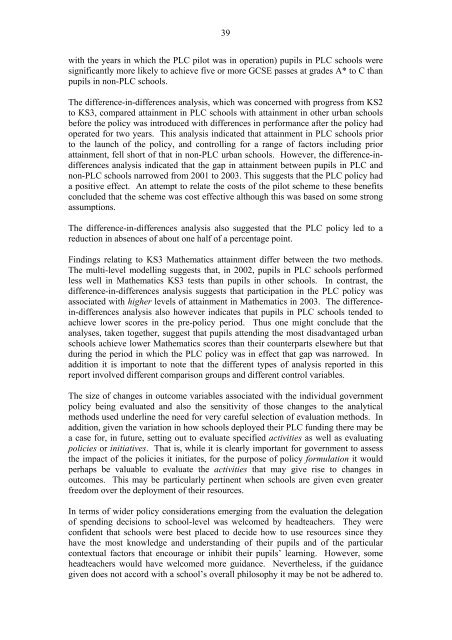Final Report of the Evaluation of the Pupil Learning Credits Pilot ...
Final Report of the Evaluation of the Pupil Learning Credits Pilot ...
Final Report of the Evaluation of the Pupil Learning Credits Pilot ...
You also want an ePaper? Increase the reach of your titles
YUMPU automatically turns print PDFs into web optimized ePapers that Google loves.
39<br />
with <strong>the</strong> years in which <strong>the</strong> PLC pilot was in operation) pupils in PLC schools were<br />
significantly more likely to achieve five or more GCSE passes at grades A* to C than<br />
pupils in non-PLC schools.<br />
The difference-in-differences analysis, which was concerned with progress from KS2<br />
to KS3, compared attainment in PLC schools with attainment in o<strong>the</strong>r urban schools<br />
before <strong>the</strong> policy was introduced with differences in performance after <strong>the</strong> policy had<br />
operated for two years. This analysis indicated that attainment in PLC schools prior<br />
to <strong>the</strong> launch <strong>of</strong> <strong>the</strong> policy, and controlling for a range <strong>of</strong> factors including prior<br />
attainment, fell short <strong>of</strong> that in non-PLC urban schools. However, <strong>the</strong> difference-indifferences<br />
analysis indicated that <strong>the</strong> gap in attainment between pupils in PLC and<br />
non-PLC schools narrowed from 2001 to 2003. This suggests that <strong>the</strong> PLC policy had<br />
a positive effect. An attempt to relate <strong>the</strong> costs <strong>of</strong> <strong>the</strong> pilot scheme to <strong>the</strong>se benefits<br />
concluded that <strong>the</strong> scheme was cost effective although this was based on some strong<br />
assumptions.<br />
The difference-in-differences analysis also suggested that <strong>the</strong> PLC policy led to a<br />
reduction in absences <strong>of</strong> about one half <strong>of</strong> a percentage point.<br />
Findings relating to KS3 Ma<strong>the</strong>matics attainment differ between <strong>the</strong> two methods.<br />
The multi-level modelling suggests that, in 2002, pupils in PLC schools performed<br />
less well in Ma<strong>the</strong>matics KS3 tests than pupils in o<strong>the</strong>r schools. In contrast, <strong>the</strong><br />
difference-in-differences analysis suggests that participation in <strong>the</strong> PLC policy was<br />
associated with higher levels <strong>of</strong> attainment in Ma<strong>the</strong>matics in 2003. The differencein-differences<br />
analysis also however indicates that pupils in PLC schools tended to<br />
achieve lower scores in <strong>the</strong> pre-policy period. Thus one might conclude that <strong>the</strong><br />
analyses, taken toge<strong>the</strong>r, suggest that pupils attending <strong>the</strong> most disadvantaged urban<br />
schools achieve lower Ma<strong>the</strong>matics scores than <strong>the</strong>ir counterparts elsewhere but that<br />
during <strong>the</strong> period in which <strong>the</strong> PLC policy was in effect that gap was narrowed. In<br />
addition it is important to note that <strong>the</strong> different types <strong>of</strong> analysis reported in this<br />
report involved different comparison groups and different control variables.<br />
The size <strong>of</strong> changes in outcome variables associated with <strong>the</strong> individual government<br />
policy being evaluated and also <strong>the</strong> sensitivity <strong>of</strong> those changes to <strong>the</strong> analytical<br />
methods used underline <strong>the</strong> need for very careful selection <strong>of</strong> evaluation methods. In<br />
addition, given <strong>the</strong> variation in how schools deployed <strong>the</strong>ir PLC funding <strong>the</strong>re may be<br />
a case for, in future, setting out to evaluate specified activities as well as evaluating<br />
policies or initiatives. That is, while it is clearly important for government to assess<br />
<strong>the</strong> impact <strong>of</strong> <strong>the</strong> policies it initiates, for <strong>the</strong> purpose <strong>of</strong> policy formulation it would<br />
perhaps be valuable to evaluate <strong>the</strong> activities that may give rise to changes in<br />
outcomes. This may be particularly pertinent when schools are given even greater<br />
freedom over <strong>the</strong> deployment <strong>of</strong> <strong>the</strong>ir resources.<br />
In terms <strong>of</strong> wider policy considerations emerging from <strong>the</strong> evaluation <strong>the</strong> delegation<br />
<strong>of</strong> spending decisions to school-level was welcomed by headteachers. They were<br />
confident that schools were best placed to decide how to use resources since <strong>the</strong>y<br />
have <strong>the</strong> most knowledge and understanding <strong>of</strong> <strong>the</strong>ir pupils and <strong>of</strong> <strong>the</strong> particular<br />
contextual factors that encourage or inhibit <strong>the</strong>ir pupils’ learning. However, some<br />
headteachers would have welcomed more guidance. Never<strong>the</strong>less, if <strong>the</strong> guidance<br />
given does not accord with a school’s overall philosophy it may be not be adhered to.

















